Khaman Dhokla Recipe
Khaman Dhokla is a popular Indian steamed savory snack made with gram flour (besan) , leavening agents and tempered with mustard seeds, curry leaves etc. It is best enjoyed with chutney and a cup of chai!
This post may contain affiliate links. Please read our disclosure policy.
Khaman Dhokla is a steamed Indian savory snack which is extremely popular in the western state of Gujarat. It is made with besan (gram flour) and leavened with leavening agents like baking soda and eno. A tempering of curry leaves, mustard seeds is often poured on it after it’s done. Khaman is best enjoyed with a side of cilantro chutney and a cup of masala chai.
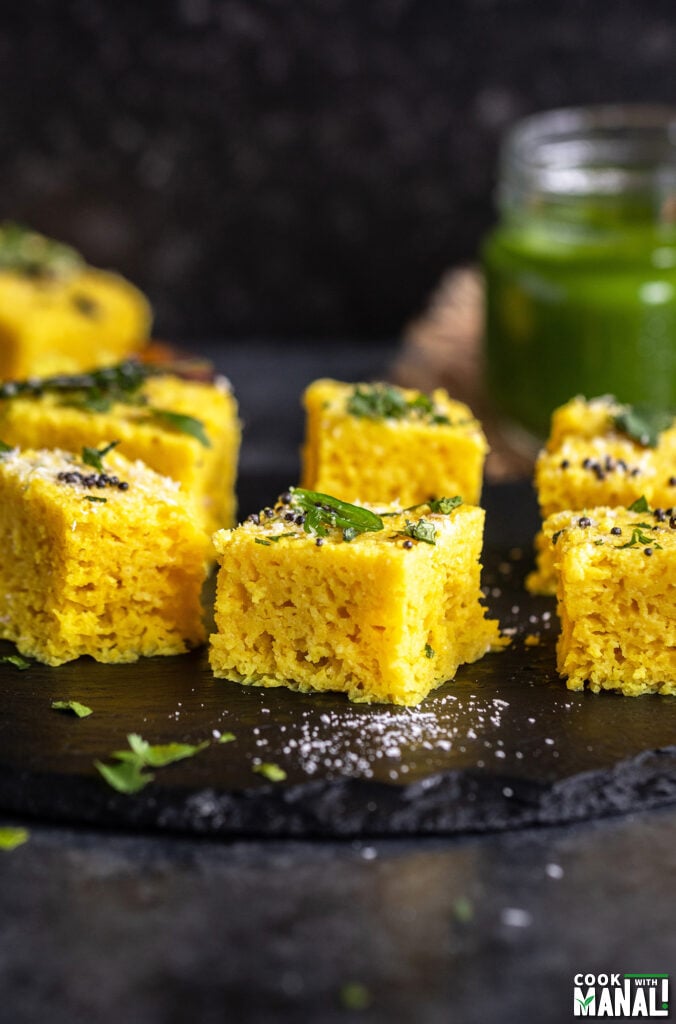
Khaman dhokla or simply khaman is a popular snack not only in Gujarat but all across the country. I grew up around Delhi and it was an extremely popular snack during tea parties, birthday parties etc. Whenever my mom had her friends over for chai, she would order samosa and khaman from the nearby sweet shops.
Difference between Dhokla and Khaman
In Delhi we would most commonly find instant khaman which is made with besan (gram flour). Khaman is often referred to as just “dhokla” in a few places, however the traditional dhokla is made very differently. Dhokla is made by a fermented rice and lentil batter (like idli). Khaman on the other hand is made with besan and uses leavening agents to make it fluffy and spongy. There’s no natural fermentation process involved in making khaman.
So, I grew up eating khaman since that is what we got in Delhi and absolutely loved it. When I moved to the US, it was not readily available here and whatever was available was stale and dry and I didn’t like it at all.
And so I had to learn how to make it. When it comes to the khaman dhokla batter, I have tried various recipes over the years and the recipe I am sharing here is the one that works best in my opinion. It makes soft and fluffy khaman that has the perfect texture. If you have been looking for that perfect khaman dhokla recipe, then look no further.
Ingredients
The batter for the khaman dhokla is made with few ingredients like:
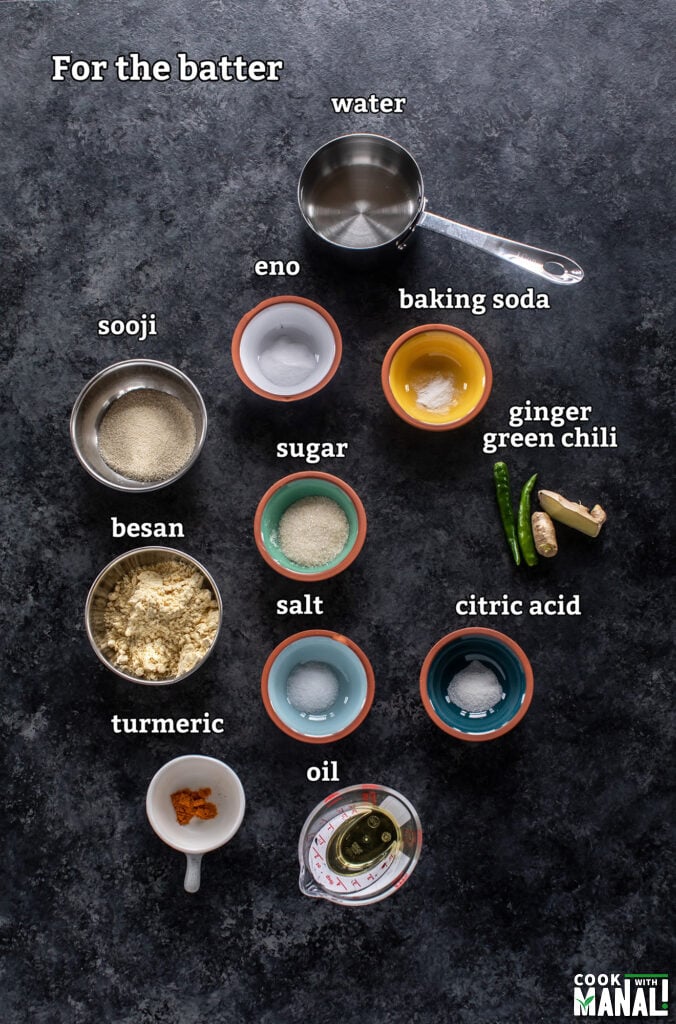
Besan: for this khaman dhokla recipe, we use regular fine variety of besan that we use for pakoras, chilla etc. To make the khaman smooth, I also sift the besan before using in the recipe.
Sooji: this is an optional ingredient but I add a tablespoon of it for texture. You can skip the sooji if you like, it would still come out just fine.
Citric acid: It is the acid which reacts with the baking soda and eno to lift the dhokla and give it that fluffy texture. You can replace this with 2 tablespoon lemon juice but for best results, please use citric acid.
ENO: also known as fruit salt is a common over the counter antacid which has sodium bicarbonate and citric acid. It is commonly used in India in cooking for lifting batters like for idli, dhokla etc. It works better than baking soda in recipes and leaves no aftertaste. You can find it at any Indian grocery store. It comes in different flavors but for cooking, you need the plain ENO (blue color bottle).
Sugar & salt: the khaman is a little sweet and a little salt and spicy and for that there’s both sugar and salt in the batter. There’s also some garlic and green chili paste for flavor and spice.
Ingredients for Tadka/Tempering
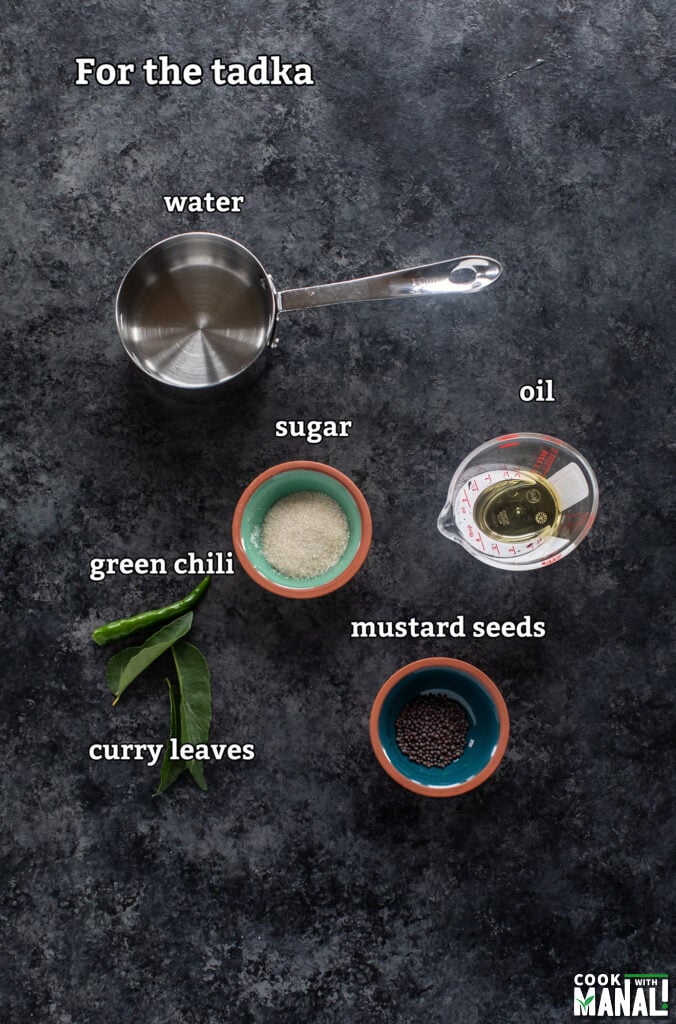
The simple tadka is made with mustard seeds, curry leaves, green chili, sugar and water. You can also add white sesame seeds in the tempering. The water is important in the tadka here, it helps in making the dhokla soft. The water is absorbed by the khaman thus making it soft.
Step by Step Instructions
1- Sift 1 & 1/2 cup besan (160 grams) and 1 tablespoon of sooji (14 grams) into a large bowl using a sifter.
2- Use a wire whisk to mix everything together. I would suggest not skipping on the sifting, it’s an extra step but make the texture of the dhokla better. Set this aside.
3- Now take another large bowl and to that add:
- 1 cup water (240 ml/8 oz)
- 2 tablespoons granulated white sugar (25 grams)
- 1 teaspoon salt
- 1 & 1/2 teaspoon ginger and green chili paste (made by crushing an inch ginger and 2 green chilies together in a food processor)
Stir with a wire whisk to combine.
4- Then add 1/4 teaspoon turmeric, 1 & 1/2 tablespoons oil (you can use any oil, I used avocado oil), and 3/4 teaspoon citric acid. Stir with a wire whisk to combine.
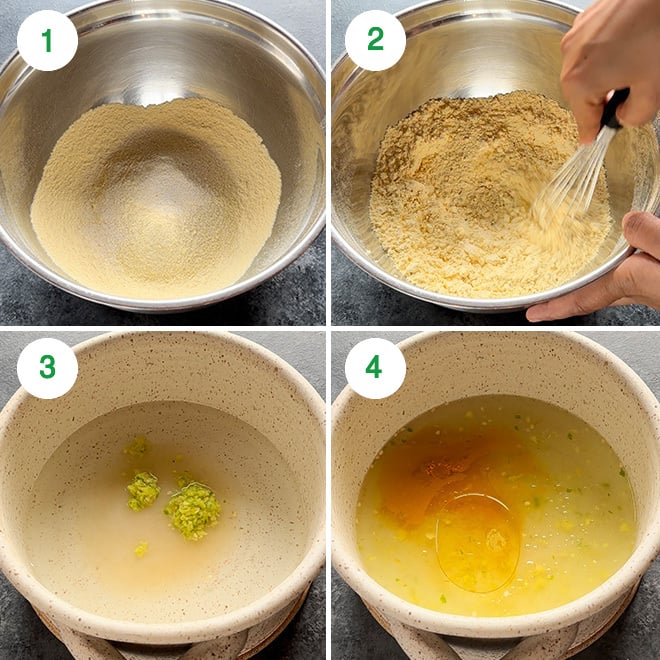
5- Add in the besan and sooji and mix until combined.
6- You should have a lump free batter which is not super thick but not runny either. IF the batter looks too thick, you can add 1 to 2 tablespoons more water at this point. Cover and let the batter rest for 10 minutes.
7- Before you do this step, make sure your steamer is ready to go. Add 2 & 1/2 to 3 cups water in your steamer and bring it to boil. The batter needs to be steamed immediately after the last step and so it’s important for the steamer to be ready. Also grease your steaming pan before this step. I used a springform pan which makes it easier to unmold the dhokla.
After 10 minutes are up, add 1/4 teaspoon baking soda and 1 teaspoon eno and mix.
8- Mix until it’s all well combined. You would notice the batter will feel light, like it has been filled with air and also become lighter in color.
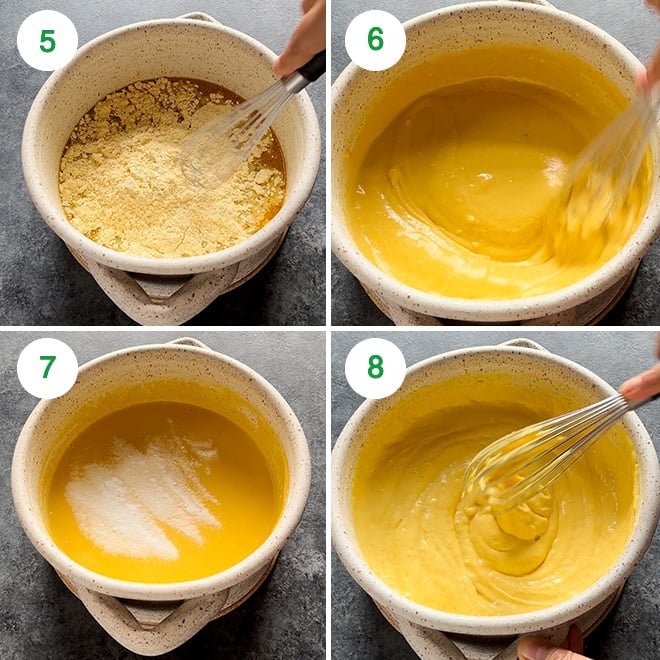
9- Transfer the batter to the greased pan immediately. I have used a 7.5-inch springform pan here but you can use any pan.
10- Level the batter using a spatula.
11- Now, place the pan into the steamer (the water should have been boiling by now and ready to go). Cover the steamer with a lid and let this steam on medium-high heat for around 15 to 16 minutes. The time will vary depending on the intensity of the heat and thickness of the steamer.
12- While the khaman is steaming, make the tadka. For the tadka, heat 2 teaspoons of oil (you can use any oil but I used avocado oil) in a small pan on medium heat. Once the oil is hot, add 1/2 teaspoon mustard seeds. Let them pop and then add 7 to 8 curry leaves, a sliced green chili, stir and then add 1/3 cup (80 ml) water. Then add 1 teaspoon sugar and a pinch of salt. Stir and remove pan from heat.
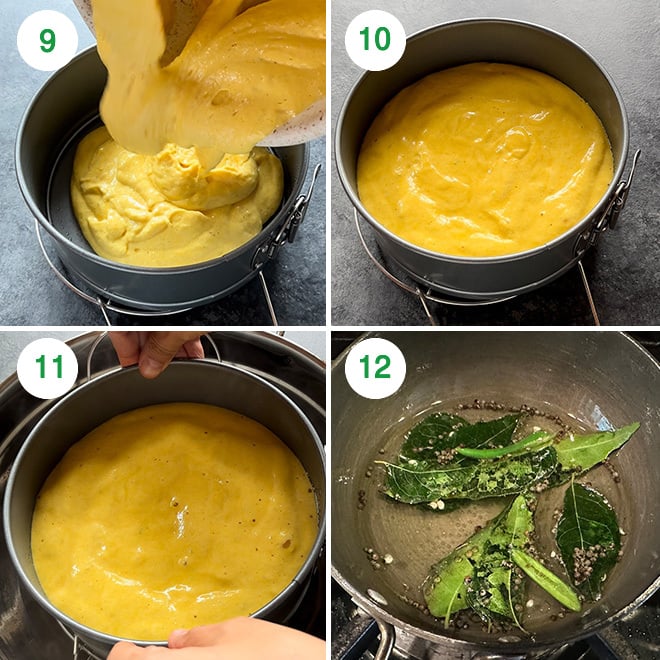
13- To check if your khaman is done, insert a knife in the center, it should come out clean. Carefully remove the pan from the steamer and let it sit for 5 minutes.
14- After 5 minutes, unmold the dhokla. Since, I used a springform pan the sides released easily, then turn the pan upside down to unmold. Since the base was greased well, it just slid off easily.
15- Once your khaman has cooled down a little, cut it into pieces. They are usually cut into squares.
16- Pour the cooled tadka over the cut khaman cubes (use a spoon to do this so that tadka is evenly distributed), making sure the water seeps in on the sides as well. Garnish with chopped cilantro, freshly grated coconut and enjoy!
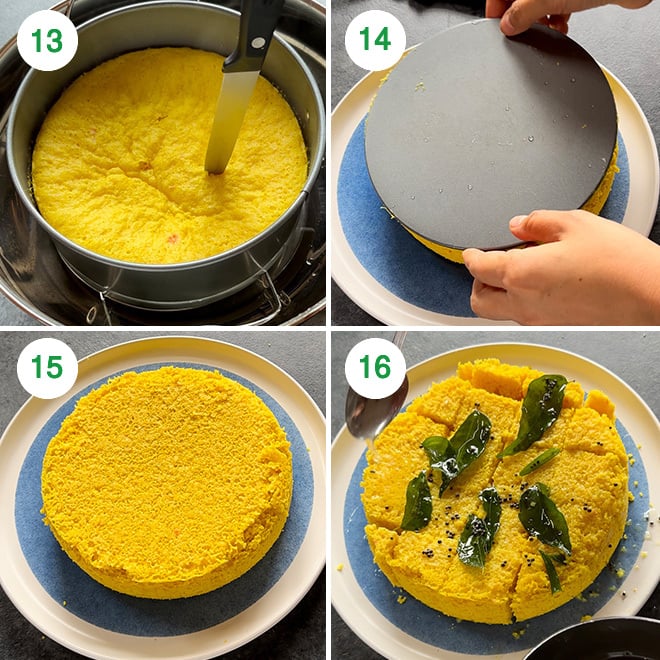
Storing Options
I store leftover khaman dhokla in an airtight container in the fridge. To re-heat, you can put it back in the steamer again and steam for a few minutes. You can also microwave for a few seconds, make sure to cover before microwaving.
Garnish with fresh cilantro and coconut just before serving. Do not add these garnished beforehand.
Serving Suggestions
You can serve khaman with chutneys like cilantro chutney, mint chutney, or tamarind chutney. I like to sometimes slice the khaman into 2 and then apply cilantro chutney on one and sweet tamarind chutney on the other side.
Steaming in the Instant Pot
You can steam khaman dhokla in the instant pot. I honestly like them more when they are steamed in a traditional steamer on the stove-top but you can definitely use your Instant Pot.
To steam dhokla in the Instant Pot, add 2 cups water in the steel bowl of the instant pot and press the sauté button. Then use the adjust button to set sauté to more and let the water come to a boil. Your pot needs to be ready for steaming before you add the eno to the batter at the last step.
Use a steel bowl which would fit inside your instant pot or you can use a 7-inch springform pan as well. Grease it and then pour the prepared batter into it. Cover with a sheet of aluminum foil. Once you see the water in the Instant Pot boiling, press the cancel button and then place a trivet inside it (use the trivet that comes with the Instant pot). Place the bowl on top of the trivet and then close the lid. Press the steam button and steam for 20 minutes on high pressure with the pressure valve in sealing position. Do a quick pressure release once the timer goes off. Remove the pan carefully and let it sit for 5 to 10 minutes before unmolding the dhokla.
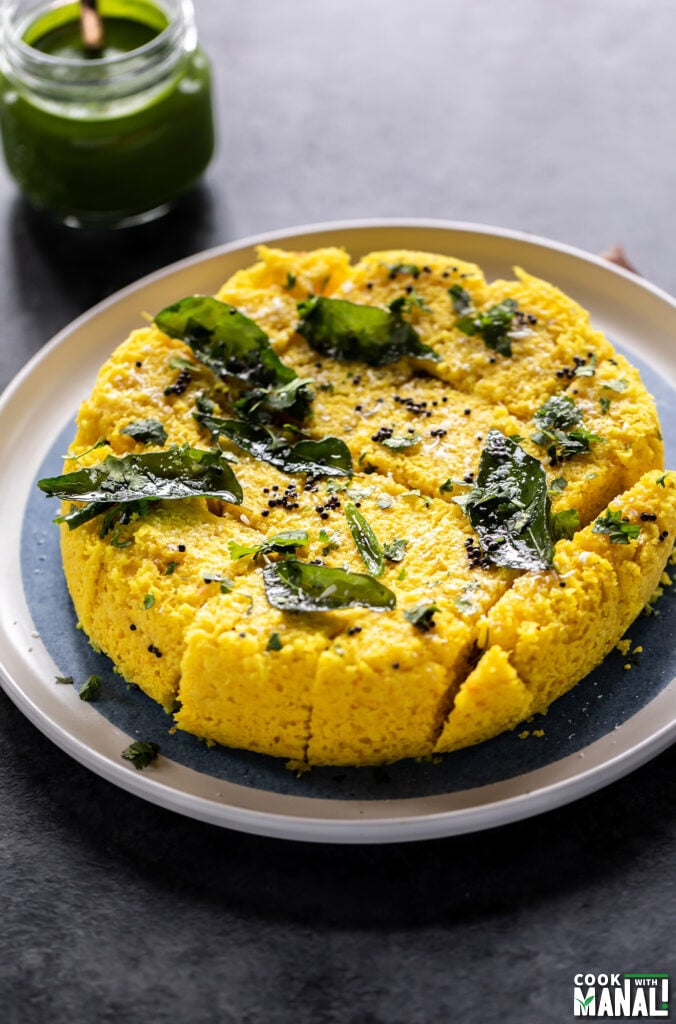
Using Springform Pan
A steel plate is commonly used to steam dhokla in traditional steamers. I like using a cake pan especially a springform pan (which is traditionally used for making cheesecakes and comes with a latch which easily separates the sides and bottom of the pan) since that not only gives enough space for the dhokla to rise but also make it super easy to unmold the dhokla. Make sure to grease the bottom and sides well so that the unmolding is easy.
Citric Acid v/s Lemon Juice
Lemon juice is a rich source of citric acid, however when you use citric acid directly, you obviously use it in its most potent form. For making spongy khaman, I definitely think citric acid works better. Can you use lemon juice in place? Most definitely but citric acid gives much better results and I would highly recommend using it.
Expert Tips & Notes
- Sift the besan before using in the recipe. Although it is an extra step, it results in a better texture. For this recipe use the fine variety of besan which we use for making pakoras, chilla etc.
- Make sure to have the steamer ready to go before you make your batter. You should be boiling the water side by side while you are working on the batter. Once the batter is done, it has to be steamed immediately.
- Add eno towards the very end and just before steaming the dhokla. Once you have added the baking soda and eno at the end, you have to stir it until the batter becomes light and fluffy and then transfer it to a pan and steam right away. If you don’t steam it immediately, your dhoklas might not turn out spongy.
- You may use 2 tablespoons of lemon juice in place of 3/4 teaspoon citric acid mentioned in the recipe. However, as I mentioned earlier, for best results please use citric acid.
- I use a little bit of baking soda and eno to lift the batter and make the dhokla airy and spongy. You can use only baking soda too but I feel it always gives an aftertaste to the dhokla which I am not a fan of. Also, the khaman which is made with baking soda alone is not as spongy or fluffy as the one made with eno. I would highly recommend using eno.
- Sometimes you will notice that khaman has red spots on it, this happens because baking soda and eno react with turmeric in the batter. If you don’t want them, you can skip the turmeric or if you are using the turmeric (like I did), make sure to mix it very well in the batter.
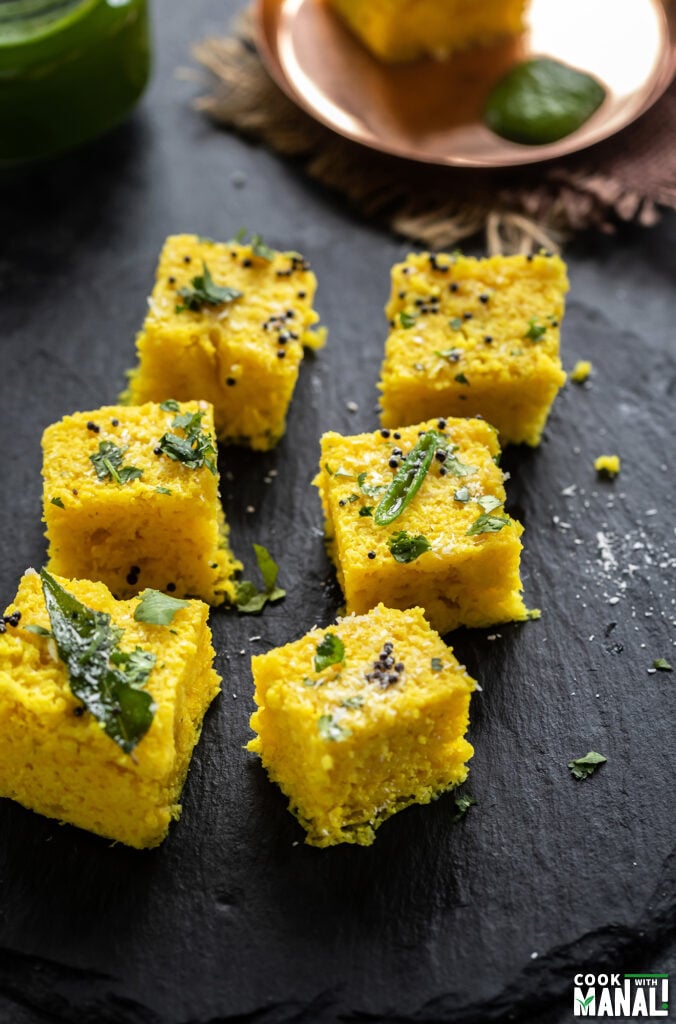
Khaman Dhokla (Soft & Fluffy)!
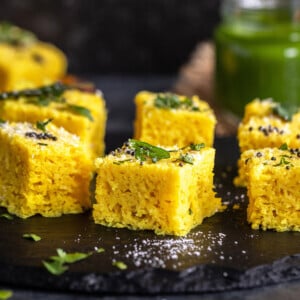
Ingredients
- 1 & 1/2 cups besan 160 grams, also known as gram flour
- 1 tablespoon sooji 14 grams, also known as semolina
- 1 cup water 240 ml/8 oz + 1-2 tablespoons if needed
- 2 tablespoons sugar 25 grams
- 1 teaspoon salt
- 1 & 1/2 teaspoon ginger-chili paste pulse together an inch of ginger and 2 green chilies in a food processor and use that
- 1/4 teaspoon turmeric
- 1 & 1/2 tablespoons oil 22 ml, I used avocado oil
- 3/4 teaspoon citric acid
- 1/4 teaspoon baking soda
- 1 teaspoon ENO also known as fruit salt, use plain ENO (blue color bottle)
For the tempering
- 2 teaspoons oil 10 ml, I used avocado oil
- 1/2 teaspoon mustard seeds
- 7-8 curry leaves
- 1/3 cup water 80 ml
- 1 teaspoon sugar
- pinch salt
- 1-2 green chili sliced
- chopped cilantro to garnish
- desiccated coconut fresh or frozen, to garnish
Instructions
Make the batter
- In a large bowl sift besan and sooji using a strainer. Mix using a wire whisk and set aside.
- To another bowl, now add 1 cup water, 2 tablespoons sugar, salt, crushed ginger-green chili paste. Stir to combine and then add turmeric, 1 & 1/2 tablespoon oil, and citric acid. Mix using a wire whisk until everything is well combined.
- Then add the sifted besan and sooji and mix to make a lump free batter. The batter needs to be on thicker side however it should not be super thick and not be runny either. You can add a tablespoon or two more water if is looks too thick at this point. Cover and let the batter rest for 10 minutes.
- Prepare your steamer while the batter is resting. It needs to be ready to go before the final step so that you can steam the batter immediately. Add 2 & 1/2 to 3 cups water in your steamer and bring it to boil. Also grease your steaming pan.After 10 minutes are up, add the baking soda eno to the batter and mix using a wire whisk. The batter will become light in color, increase in volume and feel very light as if it has been filled with air.
- Now, transfer the batter to the greased pan immediately. I used a 7.5-inch springform pan here but you can use any pan. Place the pan into the steamer and steam on high to medium-high heat for 15 to 16 minutes. You will know it is steamed when a knife inserted in the center comes out clean.
Make the tadka
- To make the tadka, heat 2 teaspoons of oil in a small pan. Once the oil is hot, add the mustard seeds and let them pop. then add curry leaves and sliced green chili and stir. Then add 1/3 cup water along with 1 teaspoon sugar and a pinch of salt. Stir until the sugar and salt dissolve and then remove pan from heat and it it cool down.
Unmold and pour the tadka
- Once the khaman dhokla is steamed, remove the pan from the steamer and let it sit for 5 to 10 minutes. Then unlock the springform pan to release the sides. Place the serving plate on top and then flip it upside down. Carefully remove the bottom of the pan.
- Let the khaman dhokla cool down a little and then cut into pieces. Pour the cooled tadka over the cut cubes using a spoon making sure the tadka and tadka water gets onto the sides of the cut cubes as well. Garnish with chopped cilantro, freshly grated coconut and enjoy with cilantro chutney.
Notes
- Please follow the recipe exactly for best results, any substitution of ingredients might yield a slightly different result.
- Combination of citric acid and eno works the best to make a soft and spongy khaman dhokla and I would highly recommend sticking to it.
Nutrition
Nutrition information is automatically calculated, so should only be used as an approximation.
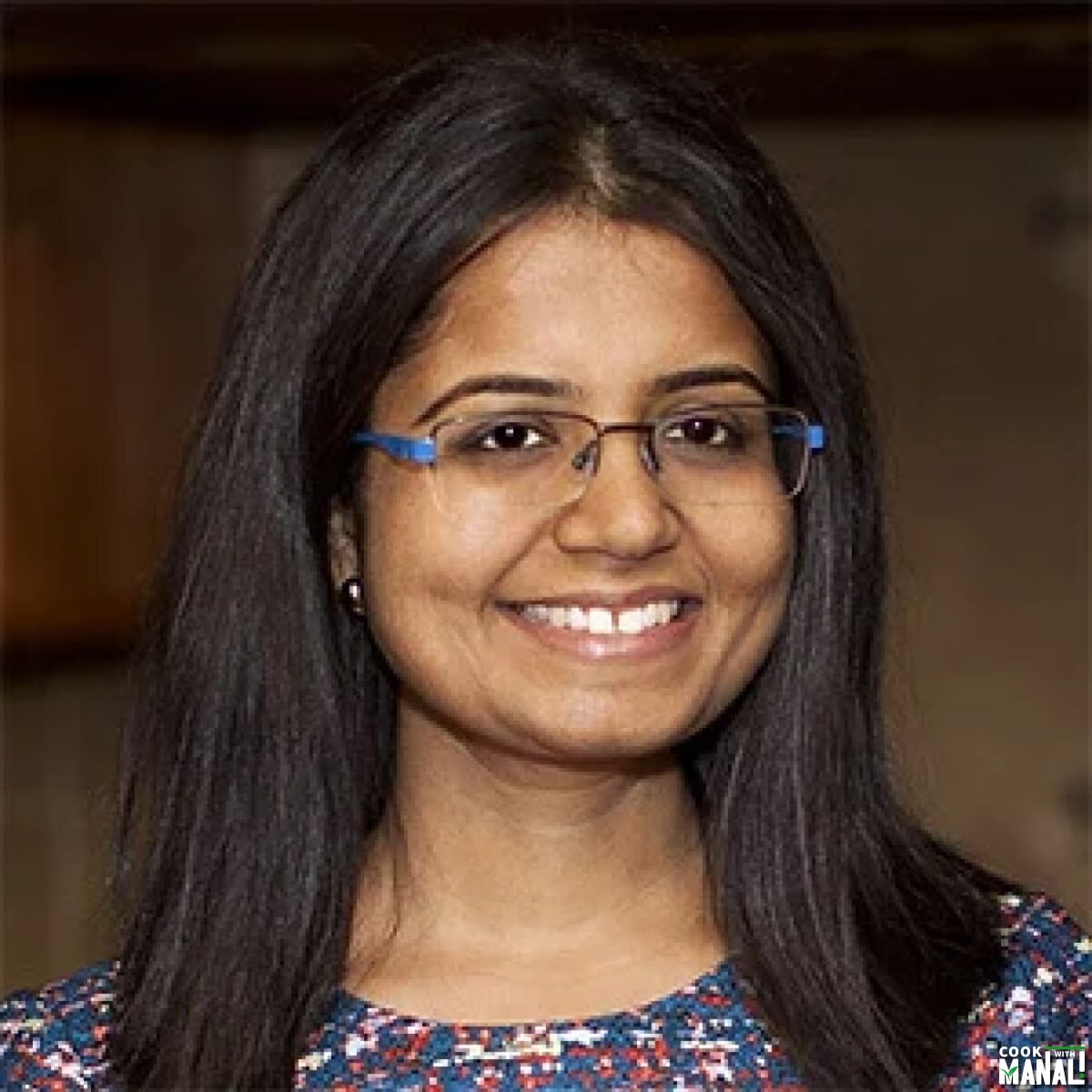
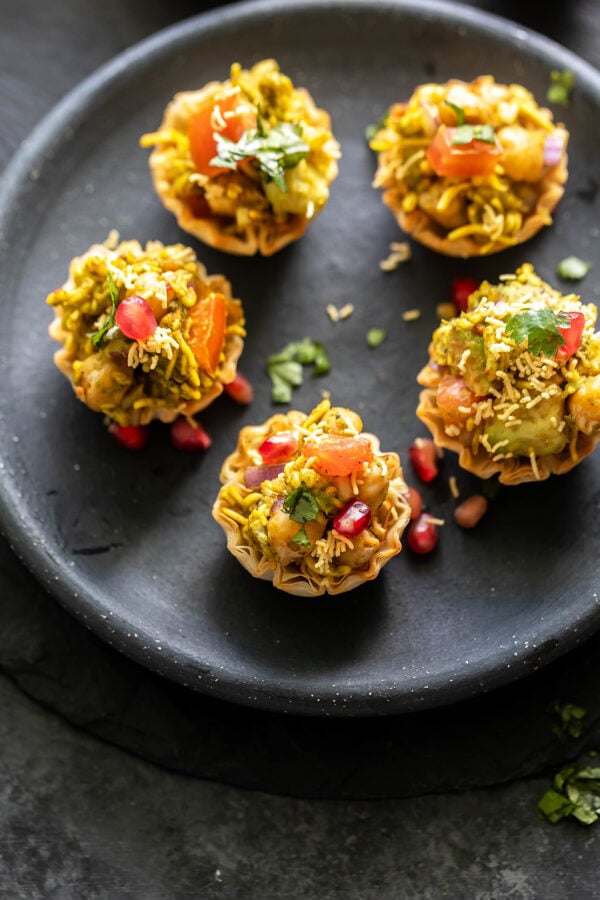
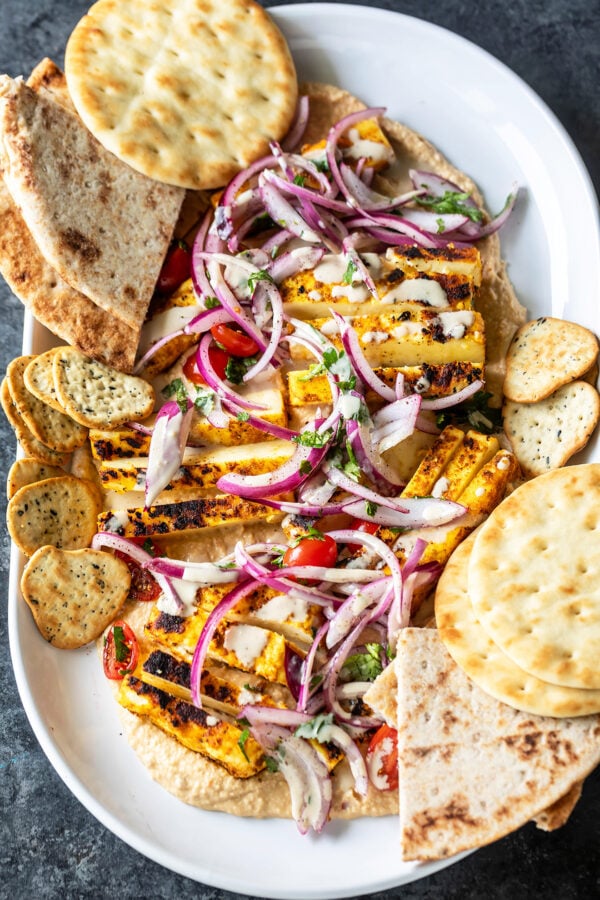
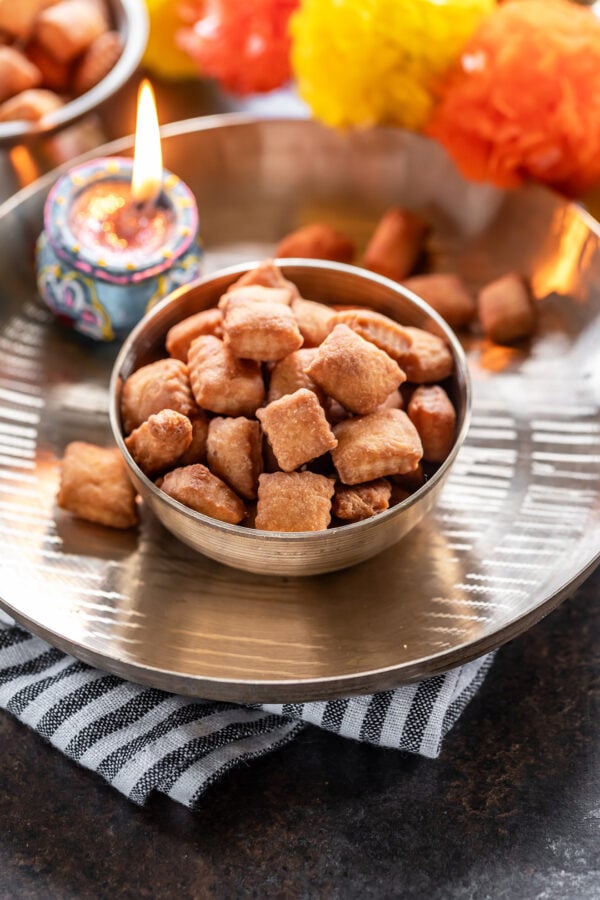
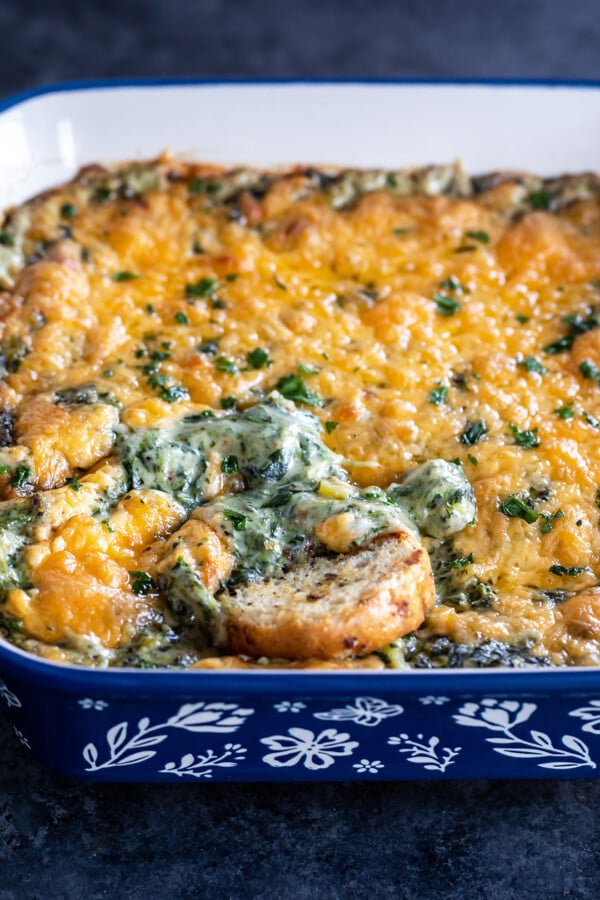









Hi Manali! Love your recipes!
What else can we use instead of ENO, my husband is allergic to it.
baking soda, so I would 1/2 teaspoon baking soda in place of 1 teaspoon eno.
Hi Mitali,
Great recipe! Khaman turned out to be perfect. Thanks a lot!
One correction:
Instruction # 1 on top says 1 cup Basen instead of 1 1/2 cup. Initially, my batter turned out to be too runny. Later on, I realized the mistake. The recipe at the bottom of the page is correct.
Thanks Mahesh for the feedback, I fixed the typo. Thanks for trying!